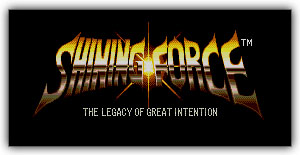
 |
|
While hardly a mainstream genre, many examples of fantastic strategy RPGs are easily found in the industry: Dragon Force, Tactics Ogre, Final Fantasy Tactics, and more. All too forgotten, though, is one of the very first strategy RPGs introduced to North American players -- Shining Force. Released back in 1993 on the Sega Genesis, Shining Force took the strategic battles of Warsong (a.k.a. Langrisser) and melded them together with a full-blown, traditional RPG engine.
One can easily excuse the countless clichés found within Climax's work. Not only were most of the plot devices relatively unused in games up to that point, but the storyline was remarkably fleshed out and decently executed for a strategy RPG. The game's prologue tells of an ancient evil, Dark Dragon, who ravaged the land of Rune precisely 1000 years ago. Rune's Ancients fought against Dark Dragon with the Powers of Light, sealing him away to another dimension, though only after the menace promised to return anew after a millenium. Fast forward to present times; a country known as Runefaust is on the rise, spreading death and destruction. The poor victims of Rune are completely bewildered by the chaos, since, of course, no one ever bothers to teach future generations of past ominous warnings. Shaking your head at having to step in and save yet another world, it is up to you to take the role of the Hero of Light and defeat the forces of darkness once more. The introduction, actually, is one of the most unique gimmicks used in the game. After the prologue, the screen opens to a scene where a young girl discovers an old and tattered book telling of the battle against Dark Dragon. With as much concern as her perky attitude can muster, she pleads with you to lead the fight. From there, the game is played out as chapters within a new, narrated book, eight chapters in all.
Of course, Shining Force, as the name and genre suggest, shines in the strategy department. (Sorry, we couldn't resist.) Battles are carried out on large, overhead square grids, and up to 12 members of your party must be arranged strategically if victory is important to you. Make no mistake -- Shining Force is a very difficult game, even for seasoned players. (This writer, unfortunately, had the most frustrating upset possible on a final boss: Dark Dragon, with 1 hit point remaining, cast Desoul on the hero immediately after his protective magic barrier fell, resulting in an instant -- and very cheap -- death. The emotional scars remain to this day.) While not quite as varied as its sequel, battles can take place almost anywhere, from within a town, climbing a tower, or onboard a sailing ship. One must also choose the right balance of characters within battles. Too many warriors, and you'll quickly be overcome by the sheer number of foes. Too many magic users, and you won't have enough brawn to back up your magic. Your forces may also be promoted to a new class once level 10 is reached, but these should be spaced out -- the resulting temporary stat decrease can leave one's party susceptible to defeat.
A total of 30 characters are waiting around the world to join your forces, either optionally or as part of the story. Unfortunately, once relegated to your forces, characters are essentially never heard from again; little character development is found anywhere. Most of your allies are quite useful in battle, however -- with the glaring exception of a bizzare helmet-clad hamster known as Jogurt the Yogurt. Utterly useless, Jogurt cannot be raised in levels and cannot deal more than 1 unit of damage. His only mildly redeeming quality is the ability to gain the "Yogurt Ring," which will allow your party to morph into Jogurt look-alikes. While the enemy forces do not collapse in fits of laughter, many twisted players will find this sadistically amusing.
Unlike the vast majority of strategy RPGs, Shining Force carries a traditional RPG engine which allows overhead exploration through towns overhead maps. You can visit shops, converse with townspeople, enter homes, read the hundreds of amusing book titles on shelves ("How Green Was My Dragon"), and venture through the overworld map to other towns and locations. The only limitation is that once you have completed a chapter in the story, you are unable to return to the areas within it -- and you are unable to find any secret characters you may have missed until you begin a new game.
Aurally and visually, Shining Force is standard fare for Genesis games of the time. Many of the tunes are rather catchy, but sadly lack decent instrumentation to pull off anything truly memorable. Graphics, while limited by the Genesis' hardware, are nonetheless impressive, particularly battle sequences. When an attack is executed, the scene switched to a third-person close-up view of the attack, followed by a report of damage and experience. Spells, especially higher-level bolt attacks, are also rather appealing. Overall, Shining Force effectively introduced the North American market to the strategy RPG genre, an area of gaming previously exclusive to Japan. Of all subsequent efforts, it is also one of the few titles to blend traditional RPG exploration and turn-based strategy together into a highly addictive package. Fans hooked onto subsequent entries in the would find it well worth their time to track down the game which started it all. Retrospective by Brian Glick, GIA. |
|
||||||||||||||||||||||||||||||||||||||||||||||||





